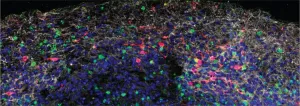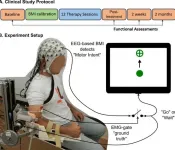Cats may help increase empathy, decrease anxiety for kids with autism
2021-01-12
(Press-News.org) COLUMBIA, Mo. - As a former school nurse in the Columbia Public Schools, Gretchen Carlisle would often interact with students with disabilities who took various medications or had seizures throughout the day. At some schools, the special education teacher would bring in dogs, guinea pigs and fish as a reward for good behavior, and Carlisle noticed what a calming presence the pets seemed to be for the students with disabilities.
Now a research scientist at the MU Research Center for Human-Animal Interaction (ReCHAI) in the MU College of Veterinary Medicine, Carlisle studies the benefits that companion animals can have on families. While there is plenty of existing research emphasizing the benefits of dogs for children with autism, Carlisle's newest study has found cats may help increase empathy while decreasing separation anxiety for children with autism. The findings can have beneficial implications for families considering adopting a companion animal for their child.
"Previous research has shown parents of kids with autism are more stressed than parents of kids with any other disability," Carlisle said. "If a family is considering adopting a companion animal, we want to provide the best evidence-based information possible so they can make an informed decision, and cats might be more beneficial than dogs to some families."
In the study, families that had children with autism aged 6-14 were recruited through the MU Thompson Center for Autism and Neurodevelopmental Disorders and monitored after adopting a cat into their home. The cats were screened for temperament to ensure they were calm and a good match for the family. Not only did the families report an instant bond between their child with autism and their new cat, but the bond remained strong over the course of time, and the child's anxiety decreased over time.
"We found the main benefit of these companion animals is their unconditional acceptance," Carlisle said. "Some children with autism may have sensory issues or be sensitive to loud noises, so a cat may be an appropriate, comforting pet for some families due to their calming presence."
Helping families make the best choice for their kids has motivated Carlisle's research with companion animals, and the study's findings highlight the benefits of human-animal interaction.
"As a former pediatric nurse, I have always strived to help children, and one thing I learned is that you need to involve the parents so they can make informed choices for their children," Carlisle said. "I see pets as a way to enhance wellness, and it feels gratifying to provide assistance to families that have a lot on their plate."
INFORMATION:
"Exploratory study of cat adoption in families of children with autism: Impact on children's social skills and anxiety" was recently published in the Journal of Pediatric Nursing. Funding for the study was provided by the Human Animal Bond Research Institute and the Winn Feline Foundation.
[Attachments] See images for this press release:

ELSE PRESS RELEASES FROM THIS DATE:
2021-01-12
New Orleans, LA - Catherine O'Neal, MD, Assistant Professor of Clinical Medicine at LSU Health New Orleans School of Medicine's branch campus in Baton Rouge, is a co-author of a paper reporting that shortening the length of quarantine due to COVID exposure when supported by mid-quarantine testing may increase compliance among college athletes without increasing risk. The findings are published in the Centers for Disease Control and Prevention's January 8, 2021 Morbidity and Mortality Weekly Report (MMWR), available here.
CDC partnered with representatives of the NCAA conferences to analyze retrospective data collected by participating colleges and universities. De-identified data from a total of 620 ...
2021-01-12
Gut microbes passed from female mice to their offspring, or shared between mice that live together, may influence the animals' bone mass, says a new study published today in eLife.
The findings suggest that treatments which alter the gut microbiome could help improve bone structure or treat conditions that weaken bones, such as osteoporosis.
"Genetics account for most of the variability in human bone density, but non-genetic factors such as gut microbes may also play a role," says lead author Abdul Malik Tyagi, Assistant Staff Scientist at the Division of Endocrinology, Metabolism, and Lipids at Emory Microbiome Research Center, Emory University, Georgia, US. "We wanted to investigate the influence of the microbiome on skeletal growth and bone mass development."
To ...
2021-01-12
Using both mouse and human brain tissue, researchers at Yale School of Medicine have discovered that SARS-CoV-2 can directly infect the central nervous system and have begun to unravel some of the virus's effects on brain cells. The study, published today in the Journal of Experimental Medicine (JEM), may help researchers develop treatments for the various neurological symptoms associated with COVID-19.
Though COVID-19 is considered to primarily be a respiratory disease, SARS-CoV-2 can affect many other organs in the body, including, in some patients, the central nervous system, where infection is associated with ...
2021-01-12
The first step in treating cancer is understanding how it starts, grows and spreads throughout the body. A relatively new cancer research approach is the study of metabolites, the products of different steps in cancer cell metabolism, and how those substances interact.
To date, research like this has focused mostly on cancerous tissues; however, normal tissues that surround tumors, known as the extratumoral microenvironment (EM), may have conditions favorable for tumor formation and should also be studied.
In a new study published in the journal PLOS ONE, researchers investigated the metabolites involved in the growth and spread of melanoma, a rare but deadly ...
2021-01-12
Almost 18,000 Americans experience traumatic spinal cord injuries every year. Many of these people are unable to use their hands and arms and can't do everyday tasks such as eating, grooming or drinking water without help.
Using physical therapy combined with a noninvasive method of stimulating nerve cells in the spinal cord, University of Washington researchers helped six Seattle area participants regain some hand and arm mobility. That increased mobility lasted at least three to six months after treatment had ended. The research team published these findings Jan. 5 in the journal ...
2021-01-12
A recent study finds that, in the wake of a mass shooting, National Rifle Association (NRA) employees, donors and volunteers had extremely mixed emotions about the organization - reporting higher levels of both positive and negative feelings about the NRA, as compared to people with no NRA affiliation.
"We wanted to see what effect 'in-group' affiliation and political identity had on how people responded to the NRA's actions after a mass shooting," says Yang Cheng, co-author of the study and an assistant professor of communication at North Carolina State University. "The political findings were predictable - Republicans thought more favorably of the NRA than Democrats did. But the in-group affiliation was a lot more complex than ...
2021-01-12
Stroke survivors who had ceased to benefit from conventional rehabilitation gained clinically significant arm movement and control by using an external robotic device powered by the patients' own brains.
The results of the clinical trial were described in the journal NeuroImage: Clinical.
Jose Luis Contreras-Vidal, director of the Non-Invasive Brain Machine Interface Systems Laboratory at the University of Houston, said testing showed most patients retained the benefits for at least two months after the therapy sessions ended, suggesting the potential for long-lasting gains. He is also Hugh Roy and Lillie Cranz Cullen Distinguished Professor of electrical and computer engineering.
The trial involved training stroke survivors with limited movement in one arm to use a brain-machine interface ...
2021-01-12
GAINESVILLE, Fla. --- Entomologist Akito Kawahara's message is straightforward: We can't live without insects. They're in trouble. And there's something all of us can do to help.
Kawahara's research has primarily focused on answering fundamental questions about moth and butterfly evolution. But he's increasingly haunted by studies that sound the alarm about plummeting insect numbers and diversity.
Kawahara has witnessed the loss himself. As a child, he collected insects with his father every weekend, often traveling to a famous oak outside Tokyo ...
2021-01-12
MANHATTAN, KANSAS -- Kyle Goerl, the medical director of Kansas State University's Lafene Health Center, is part of a collaborative team that is providing research-based guidance during the COVID-19 pandemic. The team's latest research contributed to the updated quarantine guidance from the Centers for Disease Control and Prevention.
Goerl is a co-author of the publication "Time from Start of Quarantine to SARS-CoV-2 Positive Test Among Quarantined College and University Athletes." The publication appeared in the Morbidity and Mortality Weekly Report from the CDC on Friday, Jan. 8, and involved researchers from multiple organizations and universities.
The publication was one of many that the ...
2021-01-12
Osaka, Japan -- Ultra-intense lasers with ultra-short pulses and ultra-high energies are powerful tools for exploring unknowns in physics, cosmology, material science, etc. With the help of the famous technology "Chirped Pulse Amplification (CPA)" (2018 Nobel Prize in Physics), the current record has reached 10 Petawatts (or 10^16 Watts). In a study recently published in Scientific Reports, researchers from Osaka University proposed a concept for next-generation ultra-intense lasers with a simulated peak power up to the Exawatt class (1 Exawatt equals 1000 Petawatts).
The laser, which was invented by Dr. T. H. Maiman in 1960, has one important characteristic of high intensity (or high peak power for pulse lasers): historically, laser peak ...
LAST 30 PRESS RELEASES:
[Press-News.org] Cats may help increase empathy, decrease anxiety for kids with autism





